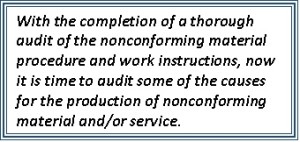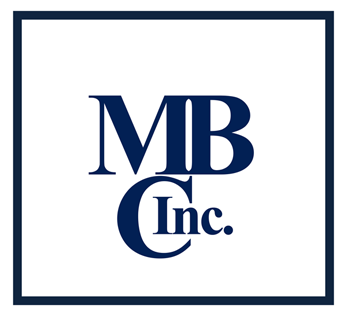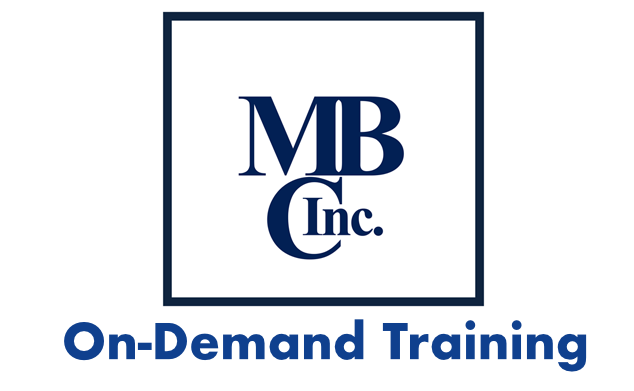MBC, Inc. Quality Tips
Internal Audit of;
ISO/TS 16949, ISO 9001 – Clause 8.3
Control of Nonconforming Product
There are several issues to deal with in clause number 8 of ISO 9001 and ISO/TS 16949. In this edition, I want to address handling of non-conforming material and some of the causes of non-conforming material that should be examined by the internal auditor. Furthermore, the auditor may be able to have a positive effect on the organization leading to reduced scrap, rework, customer complaints, etc. Too often internal auditors only look at the surface or the implementation of work rules without an examination of the requirements of the international standard, the organization’s internal procedures, the work instructions, the process flow chart or the process control plan. All these things have an effect on the production, identification and handling of nonconforming material.
To examine this activity we must examine several levels of requirements, the implementation of the requirements and the organizational discipline to follow the requirements. During surveillance audits, the registrar will always audit nonconforming material. Some organization question why so frequent an audit for this particular function? The answer is simple, the identification and handling of nonconforming or suspect material is a job function that involves many people in the organization. There are multiple steps to this procedure. When and if the procedure breaks down there is a very high likelihood of shipping nonconforming material to your customers. With the risks, being high when failure of the process occurs the reason for more frequent audit becomes apparent.
The reason for the increased audit is based on importance of the nonconforming material procedure.
This should drive most organizations to increase their internal audit of nonconforming material procedure and process as well as additional operational process audits by supervisors and other managers as to the health of this critical process. These additional operational process audits may or may not be included in the formal internal audit procedure, however I highly recommend that they be documented as part of the formal internal audit process.
Looking at the following bulleted items you will notice several questions that are of particular importance to many manufacturing and service organizations. These are questions that Middle and Top Managers should be looking into on a regular basis, in these  questions the potential cost savings and efficiency savings may be significant. Consider the dollar cost of one failure of the nonconforming material procedure that allows defective product to go to a customer. The dollar cost of sending personnel to the customer to potentially inspect and sort product, the additional freight cost of expediting good material and the return freight of the defective material. The additional potential cost of financial penalty for any lost production time at the customer as well as the potential for loss of future business. These costs can easily go to six figures and I have heard reports of containment activities going to seven figures for multiple failures at the same customer in the same fiscal year.
questions the potential cost savings and efficiency savings may be significant. Consider the dollar cost of one failure of the nonconforming material procedure that allows defective product to go to a customer. The dollar cost of sending personnel to the customer to potentially inspect and sort product, the additional freight cost of expediting good material and the return freight of the defective material. The additional potential cost of financial penalty for any lost production time at the customer as well as the potential for loss of future business. These costs can easily go to six figures and I have heard reports of containment activities going to seven figures for multiple failures at the same customer in the same fiscal year.
1. How can the organization benefit from the “Measurement, Analysis and Improvement” requirements of clause 8 of either standard?
i) How many organizations have shipped non-conforming material to a customer received a complaint and spent vast amounts of money to send personnel to the customer and sort parts?
ii) Pay the return freight for the non-conforming material.
iii) Pay premium freight to expedite good replacement material to the customer. All because someone didn’t follow defined requirements.
iv) Often this non-compliance to established methods is with the knowledge and consent of management.
1. This becomes part of the reason, some members of the organization do not believe the production requirements are justified
2. or they do not think they are required
3. or they believe they have ‘authority’ to make deviations on the fly.
i. Usually none of these things is true (1 through 3).
Let us consider an approach for the internal audit team to address this critical issue in a systematic way that is designed to bring benefit to the organization by reducing overall cost, i.e. a positive effect on the bottom-line.
First, does the organization’s nonconforming material procedure address the requirements of the international standard? To understand this we must look at clause 8.3 of the ISO 9001 and the ISO/TS 16949 Standards. Each of these documents has the exact same requirement in their respective clauses 8.3. A procedure is required for this activity and the minimum content of the procedure is;
“A documented procedure shall be established to define the controls and related responsibilities and authorities for dealing with nonconforming product.”
The internal auditor must examine the nonconforming material procedure to ensure all three of these requirements are covered. It should be noted at this point that most organizations include additional requirements. This practice is not just common but probably necessary.
Does the nonconforming material procedure layout, in sufficient detail, the “CONTROLS” needed to handle nonconforming material? The auditor needs to examine the required steps defined in the identification of nonconforming material, how it is identified, i.e. tagging, marking, isolation and segregation of the material. When the auditor is satisfied that the procedure contains clear steps to ensure nonconforming product is identified and controlled preventing its unintended use or delivery to the customer then the audit may continue. If discrepancies are found in the content of the procedure an Opportunity for Improvement should be written allowing the organization to strengthen the language of the procedure.
Does the procedure clearly define “RESPONSIBILITIES” for the identification and handling of nonconforming material? Usually responsibility is very broad and includes nearly everyone in the organization has the responsibility within their particular work activity to identify nonconforming or potentially nonconforming material and take the appropriate steps to begin the isolation and control process. Lastly, does the procedure adequately define “AUTHORITIES” for handling nonconforming material? This is usually in the form of the defined authority to assess and assign final disposition to the nonconforming or suspect material, i.e. the Material Control Team or MCT. This would also include the definition around the three primary dispositions, repair/rework, scrap or return to production (it’s Okay).
This examination of the procedure does not have to be carried out on every internal audit. Once the procedure is determined to be compliant to the standard, it will remain compliant until some change is made to the procedure or some change is made to the international standard.
Now the auditor is ready to begin the audit of nonconforming material activities by the operations departments. Here observation may become very important to the audit process. What does the auditor see happening during production? Are procedures and instruction followed with regard to suspect or nonconforming material? If tagging is involved, are the tags properly filled out at each step of the process as defined by the nonconforming material procedure? Is the material isolated as required? This is usually accomplished by placing the material on a designated table, container or by moving it to an isolation crib which may or may not be locked. Nonconformance, to the procedure would be if material is staged on the floor without identification to be moved later, tag attached but not filled out as required, etc. This is one of the areas with the greatest amount of violation simply because there are so many people involved in this step. The potential for any one of perhaps hundreds of operators may be involved at this point and any one of them may incorrectly follow the required steps due to any number of reasons such as; distractions, motivations, training, procedures or work instructions overridden by management, apathy, or misunderstanding.
With the completion of a thorough audit of the nonconforming material procedure and work instructions, now it is time to audit some of the causes for the production of nonconforming material and/or service.
Some nonconforming material production is strictly the result of processes that are not capable of holding tolerances as defined by the product or service design requirements. Some would think this to be beyond the scope of the internal audit process.
A careful examination of both standards clause 7.5.1 “The organization shall plan and carry out production and service provision under controlled conditions. Controlled conditions shall include…”
7.5.1 c) “the use of suitable equipment,”
With this requirement, the auditor has full license to question the “Suitability” of the equipment when it is demonstrated the equipment is not capable of maintaining specifications. Often the correction is not capital investment for new equipment. Often the correction is the proper set-up, monitoring, control and verification of the equipment. This says the engineering work to define proper set-up may be needed, the engineering work to define the parameters for process control including inspection frequency needs to be properly determined. All of this work may well be based in accurate studies of process capability, and statistical process control analysis of Cpk and/or Ppk as well as the completion of a comprehensive Process FMEA (Failure Mode Effects Analysis). Process capability studies often increase understanding of equipment capability. The result of proper studies may enhance the identification of the correct set-up and process control measures.
With the identification of proper process control and proper equipment set-up, the burden falls on Operations Personnel to follow the defined criteria. How often do first line supervisors feel pressured by Middle and Top Management to override proper job instructions and order operators to “short-cut” requirements resulting in nonconforming material and customer complaints? Often this Middle and Top Management pressure is “deniable” because it is not in writing and may be ordered covertly. These are areas the internal auditor may well have difficulty obtaining objective evidence. However, keep in mind, when the internal auditor finds that requirements have been “short-cut”, this may be supported by lacking required set-up and/or inspection records. This is the finding.
Does Management have the strength of character to admit to and step-up and own the blame? “THE ORDERS CAME FROM THE TOP” this may just be a perceived culture and needs Top Management intervention to change the behavior.
Good Luck! – and – Good Audit!
“The involvement of a Committed Management Team is an Unbeatable Combination”
Spread the News
Please forward these editions to others in your organization so they may receive the benefited of this newsletter. Tell other members of your company to go to www.MBCINcorp.com and sign-up for this newsletter by downloading the free report in the upper right corner of the home page.
For additional information about the Internal Audit Process, you may contact the President of MBC, Inc. at anytime; Phone 931.637.1446, or E-mail – Bmartin@MBCIncorp.com
Thank You
Bill Martin – President
MBC, Inc.

